Guest post from Tim Hardy.
Tim is a graphic designer, illustrator and history boy, he is also resident of the Pendle area. Follows a tale of Black dog as familiar, witches and the trial.
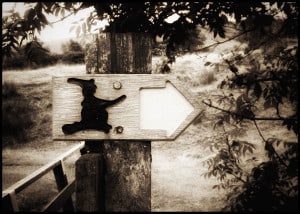 Living in the Borough of Pendle, it’s not easy to escape the area’s connection to the famous Witch Trials of 1612. From bus company logos to beer and even council literature, the pointy- hatted broomstick riding witch is everywhere. Taking centre stage in the area’s past drama is Pendle Hill itself, a gigantic slab of peat, moss and gritstone, dominating the landscape of this corner of East Lancashire, at 1,835 feet high it is only 165 feet short of being classed as a mountain. Magnificent looking when the sun shines, on a grey, wild and stormy day, not unknown in these parts, it can take on an air of menace. It was in the hamlets and villages surrounding this hill that the largest witch-hunt in English legal history took place. A sinister episode that saw the arrest and execution of ten alleged witches.
Living in the Borough of Pendle, it’s not easy to escape the area’s connection to the famous Witch Trials of 1612. From bus company logos to beer and even council literature, the pointy- hatted broomstick riding witch is everywhere. Taking centre stage in the area’s past drama is Pendle Hill itself, a gigantic slab of peat, moss and gritstone, dominating the landscape of this corner of East Lancashire, at 1,835 feet high it is only 165 feet short of being classed as a mountain. Magnificent looking when the sun shines, on a grey, wild and stormy day, not unknown in these parts, it can take on an air of menace. It was in the hamlets and villages surrounding this hill that the largest witch-hunt in English legal history took place. A sinister episode that saw the arrest and execution of ten alleged witches.
This was a turbulent time in England’s history, dominated by religious persecution and superstition. James I was King, having survived the Gunpowder Plot of seven years previous, his fear of rebellion and understandable anger brought with it harsh penalties for anyone keeping the Catholic faith, his suspicious nature allied to his firm belief in the existence of witchcraft led to the passing of an Act, imposing the death penalty, “for making a covenant with an evil spirit, using a corpse for magic, hurting life or limb, procuring love, or injuring cattle by means of charms”.
Each Justice of the Peace in Lancashire at the beginning of the year of 1612 was instructed to compile a list of all those who refused to attend Church or take communion (a criminal offence). Lancashire was regarded as wild and lawless, possibly related to the general sympathy with the Catholic Church (the people of Pendle Hill had openly opposed the closure of the nearby Cistercian Abbey at Whalley) and most reverted straight back to Catholicism when Queen Mary came to the throne in 1553. This region of Lancashire was thought of as “where the church was honoured without much understanding of its doctrines by the common people”.
Local magistrates, probably looking to find favour with King James, became zealous in their pursuit of witchcraft. When the Pendle Witches were put on trial at Lancaster Castle in August 1612, a London clerk by the name of Thomas Potts recorded the event in great detail and after his notes were published in book form in 1613, it was sent around the country as both a warning and a guide on finding evidence of witchcraft.
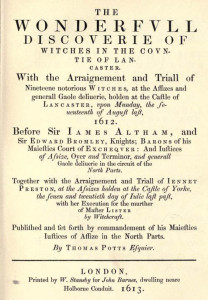 Witchcraft in the 16th Century was a widely accepted part of village life, ‘Old Demdike’ (one of the accused) had been known as a witch for fifty years, usually regarded as healers who practised magic and dealt in herbs and medicines. The extent of the spate of witchcraft reported in Pendle at this time perhaps reflected the large amounts of money people could make by posing as witches. There is certainly recorded evidence that they ran a form of ‘protection racket’, one victim, John Device, father of Alizon Device (another of the accused), agreed to give ‘Old Chattox’ (matriarch witch and Old Demdike’s chief rival) eight pounds of oatmeal each year in return for her promise not to hurt his family. The meal was handed over annually until the year before his death in 1601; on his deathbed he claimed that his sickness had been caused by his failure to pay up. Although tolerated, albeit grudgingly, on 18 March 1612, things were about to take a turn for the worse when one of Demdike’s granddaughters, Alizon Device was out begging. She encountered John Law, a peddlar from Halifax and asked him for some pins. Perhaps insignificant and no big deal by today’s standards but in the 17th century they were hand made and relatively expensive items. Did Alizon require them for the purposes of practising witchcraft? When John Law refused to ‘loose his pack’ and hand them over ‘she seemed to be very angry’.
Witchcraft in the 16th Century was a widely accepted part of village life, ‘Old Demdike’ (one of the accused) had been known as a witch for fifty years, usually regarded as healers who practised magic and dealt in herbs and medicines. The extent of the spate of witchcraft reported in Pendle at this time perhaps reflected the large amounts of money people could make by posing as witches. There is certainly recorded evidence that they ran a form of ‘protection racket’, one victim, John Device, father of Alizon Device (another of the accused), agreed to give ‘Old Chattox’ (matriarch witch and Old Demdike’s chief rival) eight pounds of oatmeal each year in return for her promise not to hurt his family. The meal was handed over annually until the year before his death in 1601; on his deathbed he claimed that his sickness had been caused by his failure to pay up. Although tolerated, albeit grudgingly, on 18 March 1612, things were about to take a turn for the worse when one of Demdike’s granddaughters, Alizon Device was out begging. She encountered John Law, a peddlar from Halifax and asked him for some pins. Perhaps insignificant and no big deal by today’s standards but in the 17th century they were hand made and relatively expensive items. Did Alizon require them for the purposes of practising witchcraft? When John Law refused to ‘loose his pack’ and hand them over ‘she seemed to be very angry’.
By her own confession, and quoting here from Thomas Potts’ account;
“The said Alison Device sayeth, that about two years agone, her grandmother, (called Elizabeth Southerns, alias old Demdike) did, sundry times in going or walking together as they went begging persuade and advise her to let a devil or a familiar appear to her; and that she would let him suck at some part of her; and she might have and do what she would. And so not long after these persuasions, she being walking towards the Roughlee, in a close, there appeared unto her a thing like unto a black dog: speaking unto her and desiring her to give him her soul, and he would give her power to do any thing she would: whereupon she being therewithal enticed, and setting her down; the said black dog did with his mouth (as she then thought) suck at her breast, a little below her paps, which place did remain blue half a year next after: which said black-dog did not appear to her, until the eighteenth day of march last.”
Witches were believed to be servants of the Devil, who would give them a familiar, a demon in animal form who acted as the Devil’s representative. People also thought that a witch, like the Devil, could transform into an animal. A black dog one of the more common forms a transformed witch or her familiar might take and witch hunters used a person’s pet black dog or a sighting of a black dog as evidence of evil.
It was now time to call on the powers her grandmother’s black dog to punish John Law for his refusal to hand over the pins.
“Presently there appeared to her the black dog, which appeared unto her as before: which black dog spoke unto her in English, saying; ‘what wouldst thou have me to do unto yonder man?’
To whom this she said, ‘what canst thou do at him?’ And the dog answered again, ‘I can lame him’: Whereupon she answered, and said to the said black dog, ‘lame him’: And before the peddler was gone forty roodes [about 300 yards] further, he fell down lame: and she then went after the said peddler, and in a house about the distance aforesaid, he was lying lame.”
John Law, most likely suffering from a mild stroke or seizure, miraculously managed to make his way to a nearby Ale-House, where, “as he lay there in great pain, not able to stir either hand or foot; he saw a great Blacke-Dogge stand by him, with very fearful fiery eyes, great teeth and a terrible countenance, looking him in the face; whereat he was very sore afraid: and immediately after came in the said Alizon Device, who stayed not long there, but looked on him and went away.”
Word got out and news of the event reached the local magistrate, Roger Nowell. Alizon, after a failed attempt at curing John Law of his ailments, was arrested, broke down and confessed, she was soon implicating other members of her family including her mother (Elizabeth), brother (James), grandmother (Elizabeth Southerns – Old Demdike) and various members of the Chattox family, well known as Old Demdike’s rivals and purportedly responsible for her father’s death. The Mafia is nothing compared to this lot.
More arrests followed and under intense interrogation their panicky attempts to either explain themselves or shift the blame to others eventually led to complete family breakdown. Alizon’s younger brother James aided and abetted by her nine year old sister Jennet now dealt the final and inevitably fatal blow by describing a grand meeting of witches at Old Demdikes house at Malkin Tower on 10 April. The reason for this meeting is unclear, but with Alizon and her grandmother safely ensconced in Lancaster Castle awaiting trial, it is likely that the participants were there to discuss their own plights in this rather calamitous situation. Alternatively, 10 April was also a Good Friday, the Demdikes were well known to be Catholic, one of the other attendees, one Alice Nutter, who, in the words of Thomas Potts was ‘a rich woman [who] had a great estate, and children of good hope: in the common opinion of the world, of good temper, free from envy or malice’, was also a known Catholic, having had two of her relatives executed as Jesuit priests, John Nutter in 1584 and his brother Robert as recently as 1600.
Was Alice on her way to a clandestine Catholic service or was the house itself being used for this purpose?
Whatever the reason, during interrogation, Jennet Device claimed that the assembled ‘coven’ were planning a rather daring gaol-break involving the blowing up of Lancaster Castle, the killing of the jailer and the release of the imprisoned witches held therein! A mass arrest followed and Alice was inevitably ‘damned by association’.
In short, we had the perfect conspiracy against Royal Authority, not only Catholic in nature, but containing an unhealthy dose of witchcraft and superstition. The local population was also keen to seal their fate and was more than willing to provide evidence of witchcraft, no matter how far fetched and dubious it appeared. In effect, they were presented with the perfect opportunity to get rid of these troublesome families, who, as one wry commentator noted, if they’d been alive today, they would probably have all been serving ASBOs!
Instrumental in giving such damning evidence against her own family during the interrogation, the prosecution’s star witness was none other than Jennet Device, Elizabeth Device’s daughter and Alizon’s younger sister. Had she been groomed by Nowell? Jennet was illegitimate and never knew her father; she grew up believing she was ‘the bastard daughter of the house’ and that she was somehow cursed. Was she taking the ultimate revenge?
The trial took place at Lancaster Assizes and began on 17 August 1612, with Judge Bromley presiding, accompanied by Judge Altham.
The prisoners were not allowed to have defence counsel to plead for them, nor could they call any witnesses to speak on their behalf. Unusually, and setting a precedent for future witchcraft trials under the direct command and order of King James who stated in his book titled Demonology, ‘Children, women and liars can be witnesses over high treason against God.’ Jennet Device was allowed to testify at the slender age of nine whereas the previous lower age limit had been set at fourteen years.
Elizabeth Device, described by Potts as “this odious witch” (she suffered from a facial deformity resulting in her left eye being set lower than her right so she certainly looked the part) upon seeing that her daughter was about give evidence against her, began to scream and curse, forcing the judges to have her removed from the courtroom before the evidence could be heard.
The trial ended on 19 August. The following day, the ten accused were led the short distance from Lancaster Castle to the aptly named Gallows Hill and hanged.
Old Demdike avoided the hangman’s noose by dying in her cell before the trial commenced.
Alice Nutter and several other defendants defied convention by refusing to offer any confession on the gallows. To many of those present at the hanging this would have seemed like proof of innocence, and it may have been such rumblings about the trial that prompted the trial judges to ask the clerk of the court, Thomas Potts, to take the unusual step of publishing an account of it. In truth Potts had already had a large hand in organising the trial itself and may well have suggested the publication in the first place. He certainly used it to curry favour with King James I, whose book Demonology he cited several times, proclaiming how the authorities had followed the King’s advice on uncovering cases of witchcraft in the Lancashire trial. The Lancashire trial was then cited from the 1620s onwards as the legal precedent for using child and ‘supergrass’ evidence in witchcraft cases. Indirectly, the trial of the Lancashire witches may have influenced the notorious ‘witchfinder-general’ trials of the 1640s and even the Salem witch trials of the 1690s in New England.
In a twist of fate, twenty years later in 1633, Jennet Device herself would be accused of witchcraft and ironically her accuser was a ten year old child by the name of Edmund Robinson, claiming that he had been bewitched whilst picking berries his father took him from village to village in an effort to point out those responsible for his ‘bewitchment’. Twenty people were arrested including Jennet and put on trial the following year. Although she was acquitted of the charge of witchcraft, she was not allowed to leave Lancaster Castle until she had paid for her board for the time she had spent there on trial. For someone like Jennet, that would have been impossible. It is highly likely that she perished in the castle.
The last known record of Jennet Device was in 1636.
In 1998 a petition was handed in to the then Home Secretary Jack Straw, asking for the witches to be pardoned, but it was decided that their convictions should stand.
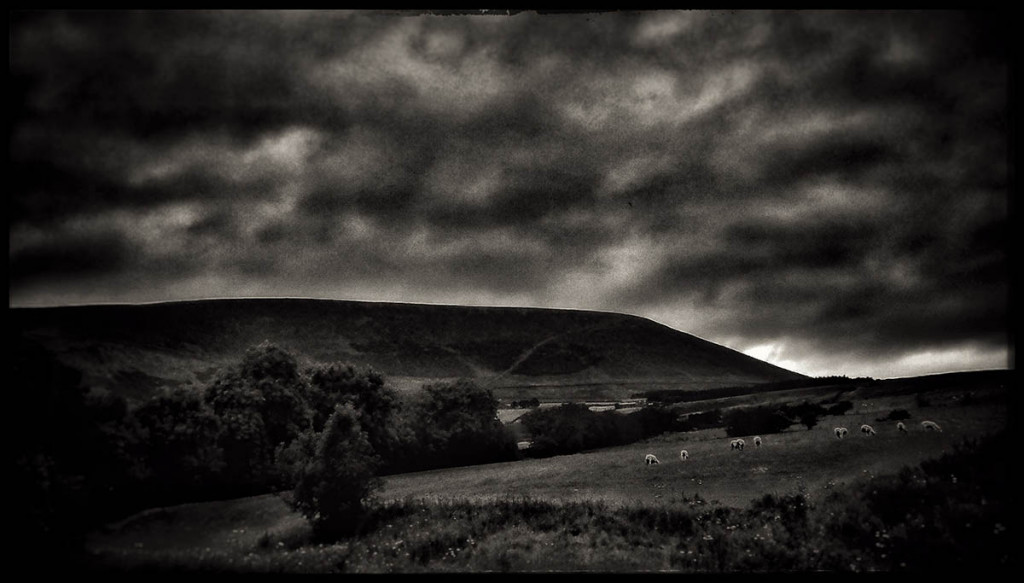
Footnote:
The Discovery of Malkin Tower. Lancashire Telegraph 8 December 2011
A chance discovery may have unearthed the ancient site where the Pendle Witches held their infamous coven.
Just ahead of the 400th anniversary of the Pendle Witch trials, archaeologists believe the find could be Lancashire’s equivalent of the unearthing of Tutankhamen’s tomb. Engineers undertaking maintenance work on Lower Black Moss reservoir, near Barley, on behalf of United Utilities, came across a mysterious mound and began to probe further.
Underneath the earthworks were the remains of a 17th-century cottage, which could be Malkin Tower, the dwelling where Elizabeth Device held a witches’ gathering on Good Friday in 1612.
And hidden within the walls, possibly to ward off evil spirits, were the remains of mummified cat.
Heritage expert Simon Entwistle, who conducts tours of Pendle Hill and the surrounding area, is convinced the find is linked to the witch trials.
He said: “It is one of those places which historians can’t quite agree upon.
“But it is certainly within the right area. This is a place that wanted to be discovered I feel, especially with the 400th anniversary of the Pendle Witch Trials. This is the epicentre of the story, and if it is not Malkin Tower, then there is a strong possibility it is linked to one of those involved.”
Archaeologists have confirmed that the property dates back to the 1600s.
And discussions are set to take place over how the site may be preserved.
Carl Sanders, a United Utilities project manager, said: “It’s not often you come across a fairytale cottage complete with witch’s cat. The building is in remarkable condition. You can walk through it and get a real sense that you’re peering into the past.”
Mr. Entwistle said: “In terms of significance, it’s like discovering Tutankhamen’s tomb.”
Frank Giecco, from Cumbria based NP Archaeology, led excavations on site at the cottage.
He said: “It’s like discovering your own little Pompeii. We rarely get the opportunity to work with something that is so well preserved. As soon as we started digging, we found the tops of doors, and knew we were onto something special. The building is a microcosm for the rise and fall of this area, from the time of the Pendle witches to the industrial age.”
Despite the excitement generated by this find, the site was filled in and nothing now remains to show where it actually existed, the main reason given was that they didn’t want to encourage hordes of tourists to trample over what is in effect, private land. The other consideration was that the remains could attract the rather more unsavoury elements of the local Devil worshipping fraternity.
The Witches are still an emotive subject in this part of Lancashire. Council plans to emblazon the number ‘1612’ on Pendle Hill as part of the 400th year anniversary of the trials were scuppered by both the local residents and the Bishop of Burnley. Eventually the project went ahead after the local brewery, Moorhouses, obtained permission from the landowner and agreed to fund the project.
As you enter the village of Roughlee today, you will be greeted by a rather splendid life sized statue of poor Alice Nutter who apart from answering ‘Not Guilty’ to the charge of witchcraft, remained silent throughout the rest of her trial. A few days ago, I ventured to take a few photographs of this statue and noticed that somebody had rather carefully placed a laminated four-leafed clover in her cloak fastening. I couldn’t help thinking that the gesture was about 400 years too late.
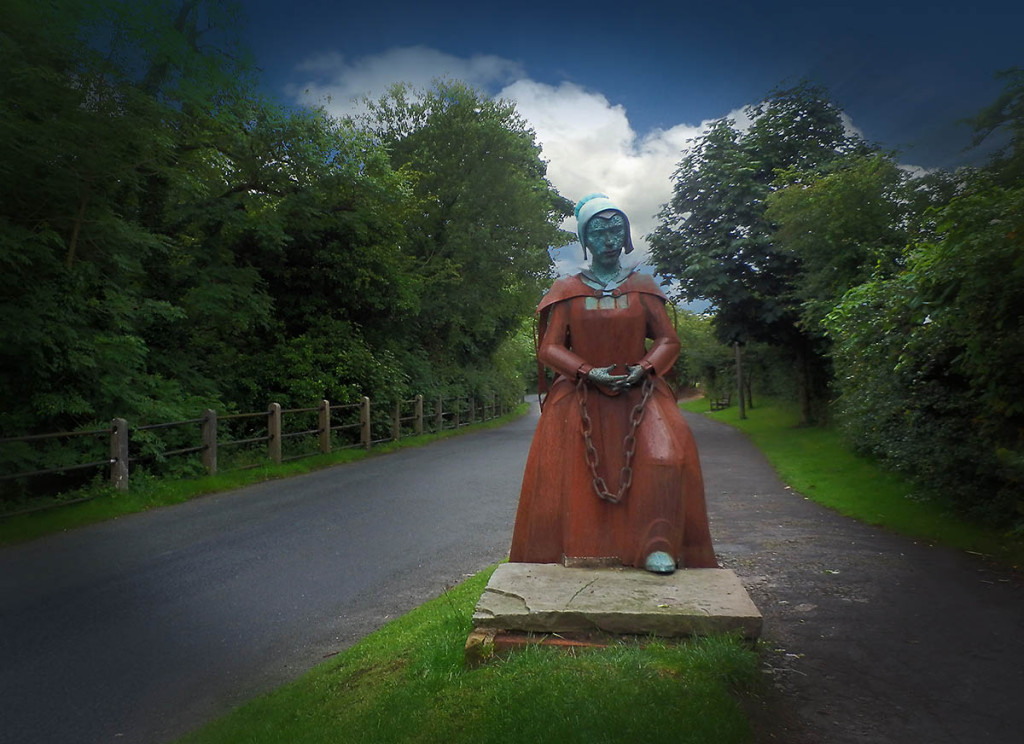
Further reading:
Full reproduction and free download of Thomas Pott’s book of the trial is available here: https://archive.org/details/pottsdiscoveryof00pottrich
Pendle Witches Website: http://www.pendlewitches.co.uk
Lancaster Castle: http://www.lancastercastle.com
All text and Pictures: © Tim Hardy.


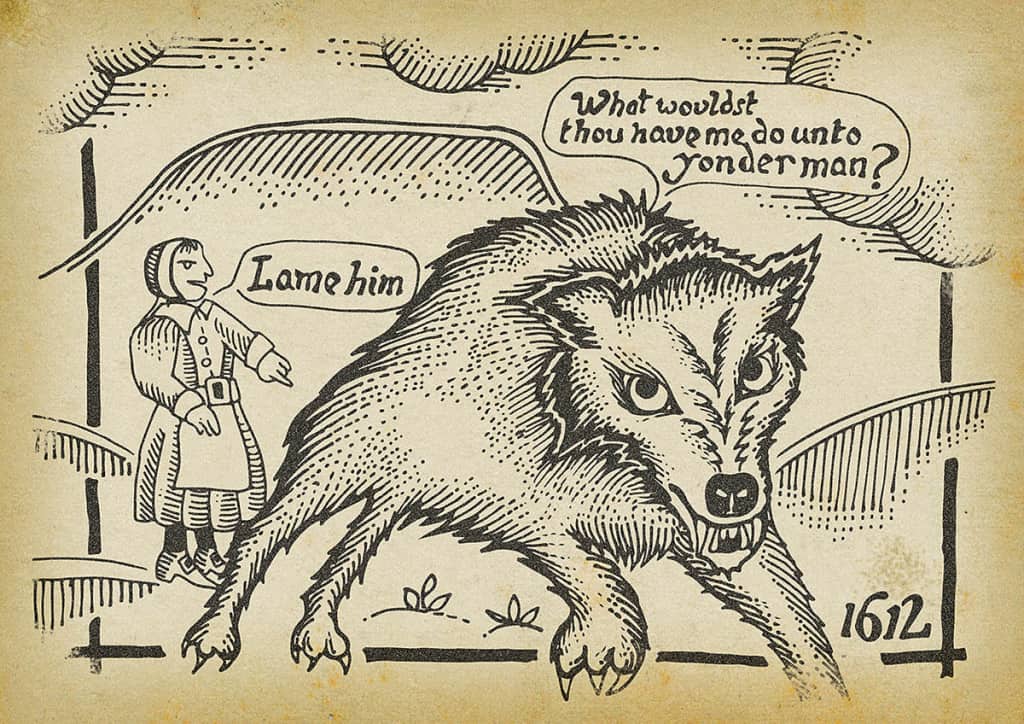

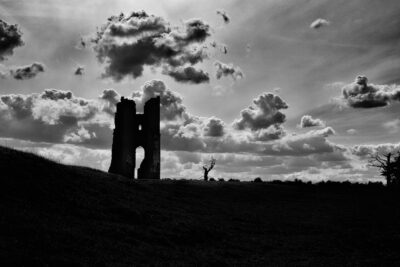
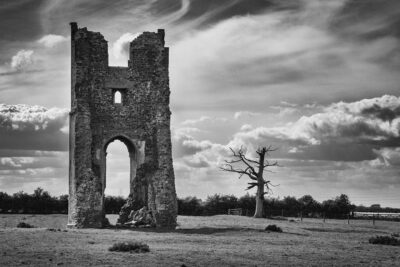
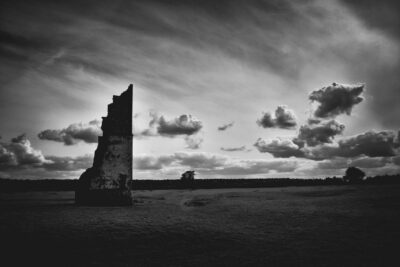
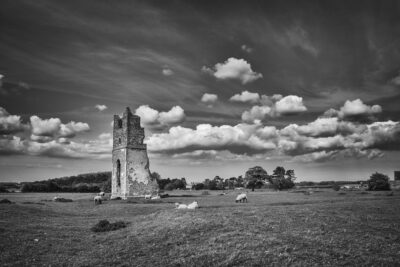
Dear Invisible Works,
Thank you for this informative and stimulating summary of Thomas Potts’ publication. I am a writer working in the Seamus Heaney Centre at Queen’s University in Belfast and wish to share my research into the case of Elizabeth Sawyer, a Middlesex woman who was hanged for witchcraft at Tyburn 400 years ago. I am about to publish ‘Elizabeth Sawyer: A Story in Maps’ online and wish to use Potts’ title page of his original 1612 publication – it’s such a useful example of the genre. Do you know who owns the copyright to the image used above (fourth from top)? I have applied to Carnegie Publishing who produced Robert Poole’s book on the same but have heard of nothing back.
Best wishes,
Jonathan Vischer